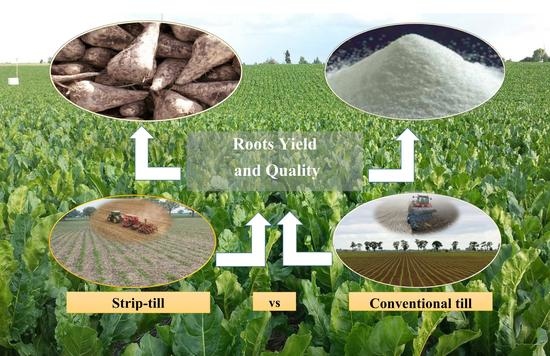Effect of Strip-Till and Variety on Yield and Quality of Sugar Beet against Conventional Tillage
Abstract
1. Introduction
2. Materials and Methods
2.1. Experimental Design
2.2. Plant Material
2.3. Sample Collection and Analysis
- Pol—sugar content (%);
- K, Na, N-α—the content of potassium, sodium, α—amino-nitrogen (mmol 100 g−1);
- YRY—root yield (Mg ha−1);
- YST—technological sugar yield.
2.4. Statistical Methods
2.5. Weather Conditions
3. Results
3.1. Root Yield and Technological Sugar Yield
3.2. Qualitative Assessment of Sugar Beets
3.2.1. Sugar Content
3.2.2. Content of Potassium, Sodium and α-Amino-Nitrogen in Roots
4. Discussion
5. Conclusions
Author Contributions
Funding
Institutional Review Board Statement
Informed Consent Statement
Data Availability Statement
Acknowledgments
Conflicts of Interest
References
- Golinowska, M.; Zimny, L. Profitability of chemical protection and production costs in selected systems of sugar beet cultivation. Prog. Plant. Prot. 2015, 55, 391–398. [Google Scholar] [CrossRef]
- Food and Agriculture Organization (FAO). Available online: https://www.fao.org/faostat/en/ (accessed on 17 January 2022).
- Institute of Agricultural and Food Economics National Research Institute (IERiGZ). Available online: https://www.ierigz.waw.pl/ (accessed on 17 January 2022).
- GUS. Statistics Poland, National Statistical Office. Available online: https://bdl.stat.gov.pl/ (accessed on 17 January 2022).
- EU Agricultural Outlook for Markets, Income and Environment 2020–2030, Brussel. Available online: https://ec.europa.eu/info/sites/info/files/food-farming-fisheries (accessed on 17 January 2022).
- Abo-Shady Kh, A.; Hilal, S.M.M.; El-Sheref, E.E.M.; Ibrahim, M.F.M. Yield and quality of subarbeet crop as affected by irrigation interval, cultivars and potassium fertilization in north delta. J. Agric. Res. 2010, 36, 361–376. [Google Scholar]
- Brar, N.S.; Dhillon, B.S.; Saini, K.S.; Sharma, P.K. Agronomy of sugarbeet cultivation—A review. Agric. Rev. 2015, 36, 184–197. [Google Scholar] [CrossRef]
- Koch, H.; Dieckmann, J.; Büchse, A.; Märländer, B. Yield decrease in sugar beet caused by reduced tillage and direct drilling. Eur. J. Agron. 2009, 30, 101–109. [Google Scholar] [CrossRef]
- Morris, N.L.; Miller, P.C.H.; Orson, J.H.; Froud-Williams, R.J. The adoption of non-inversion tillage systems in the United Kingdom and the agronomic impact on soil, crops and the environment—A review. Soil Till. Res. 2010, 108, 1–15. [Google Scholar] [CrossRef]
- Zimny, L.; Zych, A.; Wacławowicz, R. Systemy uprawy buraka cukrowego w Polsce w badaniach ankietowych. Zesz. Probl. Post. Nauk Rol. 2015, 581, 135–145. [Google Scholar]
- Jaskulska, I.; Najdowski, Ł.; Gałęzewski, L.; Kotwica, K.; Lamparski, R.; Piekarczyk, M.; Wasilewski, P. The effect of all-surface ploughless tillage and strip-till on fuel consumption, yields and the quality of sugar beet roots. Fragm. Agron. 2017, 34, 58–65. [Google Scholar]
- Laufer, D.; Loibl, D.; Märländer, B.; Koch, H.J. Soil erosion and surface runoff under strip tillage for sugar beet (Beta vulgaris L.) in Central Europe. Soil Till. Res. 2016, 162, 1–7. [Google Scholar] [CrossRef]
- Rajewski, J.; Zimny, L.; Kuc, P. The effect of varying variants of sugar beet conservation tillage on chemical soil properties. Fragm. Agron. 2012, 29, 98–104. [Google Scholar]
- Reeder, R. Consider Strip Tillage to Alleviate Soil Compaction. 2002. Available online: http://www.agriculture.com/default.sph/AgNews.class?FNC=DetailNewsAsearchlistAg–News.html48797 (accessed on 12 July 2018).
- Gaj, R.; Budka, A.; Niewiadomska, A.; Przybył, J.; Mioduszewska, N. Effect of different tillage methods on the nutritional status, yield and quality of sugar beets. J. Elem. 2015, 20, 571–584. [Google Scholar] [CrossRef]
- Mudarisov, S.G.; Safin, H.M.; Farkhutdinov, I.M.; Aminov, R.I. Agrotechnical and energy assessment of strip tillage machine in field conditions. In BIO Web of Conferences; EDP Sciences: Les Ulis, France, 2020; Volume 17, p. 00248. [Google Scholar]
- Soane, B.D.; Ball, B.C.; Arvidsson, J.; Basch, G.; Moreno, F.; Roger-Estrade, J. No-till in northern, western and south-western Europe: A review of problems and opportunities for crop production and the environment. Soil Till. Res. 2012, 118, 66–87. [Google Scholar] [CrossRef]
- Jaskulska, I.; Jaskulski, D. Strip-till one-pass technology in Central and Eastern Europe: A MZURI Pro-til hybrid machine case study. Agronomy 2020, 10, 925. [Google Scholar] [CrossRef]
- Laufer, D.; Koch, H.J. Growth and yield formation of sugar beet (Beta vulgaris L.) under strip tillage compared to full witdth tillage on silt loam soil in Central Europe. Eur. J. Agron. 2017, 82, 182–189. [Google Scholar] [CrossRef]
- Evans, R.G.; Stevens, W.B.; Iversen, W.B. Development of strip tillage on sprinkler irrigated sugarbeet. Appl. Eng. Agric. 2010, 26, 59–69. [Google Scholar] [CrossRef]
- Tarkalson, D.; Bjorneberg, D.; Moore, A. Effects of tillage system and nitrogen supply on sugarbeet production. J. Sugar Beet Res. 2012, 49, 79–102. [Google Scholar] [CrossRef]
- Mioduszewska, N.; Adamski, M.; Osuch, E.; Osuch, A. Sugar beets grown in the strip-tillage system at different soil cultivation depths. Farm Machinery and Processes Management in Sustainable Agriculture. In Proceedings of the X International Scientific Symposium FMPMSA 2019, Lublin, Poland, 20–22 November 2019. [Google Scholar] [CrossRef]
- Wenninger, E.J.; Lojewski, J.A.; Vogt, J.R.; Morishita, D.W.; Neher, O.T.; Daku, K.E. Effects of strip tillage and irrigation rate on sugar beet crop yield and incidence of insect pests, weeds, and plant pathogens. J. Sugar Beet Res. 2019, 56, 79–110. [Google Scholar] [CrossRef]
- Peigne, J.; Ball, B.C.; Roger-Estrade, J.; David, C. Is conservation tillage suitable for organic farming? Soil Use Manag. 2007, 23, 129–144. [Google Scholar] [CrossRef]
- Krause, U.; Koch, H.; Maerlander, B. Soil properties effecting yield formation in sugar beet under ride and flat cultivation. Eur. J. Agron. 2009, 31, 20–28. [Google Scholar] [CrossRef]
- Sip, V.; Vavera, R.; Chrpova, J.; Kusa, H.; Ruzek, P. Winter wheat yield and quality related to tillage practice, input level and environmental conditions. Soil Till. Res. 2013, 132, 77–85. [Google Scholar] [CrossRef]
- Verch, G.; Kächele, H.; Hőlti, K.; Richter, C.; Fuchs, C. Comparing the profitabilty of tillage methods in Northest Germany—A field trial from 2002 to 2005. Soil Till. Res. 2009, 104, 16–21. [Google Scholar] [CrossRef]
- Freibauer, A.; Rounsevell, M.D.A.; Smith, P.; Verhagen, J. Carbon sequestrion in the agricultural soils of Europe. Geoderma 2004, 122, 1–23. [Google Scholar] [CrossRef]
- Bending, G.D.; Putland, C.; Rayns, F. Changes in microbial community metabolism and labile organic matter fractions as early indictors of the impact of management on soil biological quality. Biol. Fertil. Soils 2000, 31, 78–84. [Google Scholar] [CrossRef]
- Bending, G.D.; Turner, M.K.; Jones, J.E. Interaction between crop residue and soil organic matter quality and the functional diversity of soil microbial communities. Soil Biol. Biogeochem. 2002, 34, 1073–1082. [Google Scholar] [CrossRef]
- Overstreet, L.F. Strip tillage for sugar beet production. Int. Sugar J. 2009, 111, 292–304. [Google Scholar]
- Saldukaitė, L.; Šarauskis, E.; Zabrodskyi, A.; Adamavičienė, A.; Buragienė, S.; Kriaučiūnienė, Z.; Savickas, D. Assessment of energy saving and GHG reduction of winter oilseed rape production using sustainable strip tillage and direct sowing in three tillage technologies. Sustain. Energy Technol. Assess. 2022, 51, 10191. [Google Scholar] [CrossRef]
- Lekavičienė, K.; Šarauskis, E.; Naujokienė, V.; Buragienė, S.; Kriaučiūnienė, Z. The effect of the strip tillage machine parameters on the traction force, diesel consumption and CO2 emissions. Soil Till. Res. 2019, 192, 95–102. [Google Scholar] [CrossRef]
- Šarauskis, E.; Vaitauskienė, K.; Romaneckas, K.; Jasinskas, A.; Butkus, V.; Kriaučiūnienė, Z. Fuel consumption and CO2 emission analysis in different strip tillage scenarios. Energy 2017, 118, 957–968. [Google Scholar] [CrossRef]
- Kusek, G.; Ozturk, H.H.; Akdemir, S. An assessment of energy use of different cultivation methods for sustainable rapeseed production. J. Clean. Prod. 2016, 112, 2772–2783. [Google Scholar] [CrossRef]
- Jabro, J.D.; Stevens, W.B.; Iverson, W.M.; Evans, R.G.; Allen, B.L. Crop water productivity of sugarbeet as affected by tillage. Agron. J. 2014, 106, 2280–2286. [Google Scholar] [CrossRef]
- Licht, M.; Al-Kaisi, M. Strip-tillage effect on seedbed soil temperature and other soil physical properties. Soil Till. Res. 2005, 80, 233–249. [Google Scholar] [CrossRef]
- Fernández, F.G.; Sorensenb, B.A.; Villamil, M.B. A comparison of soil properties after five years of no-till and strip-till. Agron. J. 2015, 107, 1339–1346. [Google Scholar] [CrossRef]
- Strickland, T.C.; Scully, B.T.; Hubbard, R.K.; Sullivan, D.G.; Abdo, Z.; Savabi, M.R.; Lee, R.D.; Olson, D.M.; Hawkins, G.L. Effect of conservation practices on soil carbon and nitrogen accretion and crop yield in a corn production system in the southeastern coastal plain. J. Soil Water Conserv. 2015, 70, 170–181. [Google Scholar] [CrossRef]
- Al-Kaisi, M.M.; Douelle, A.; Kwaw-Mensah, D. Soil microaggregate and macroaggregate decay over time and soil carbon change as influenced by different tillage systems. J. Soil Water Conserv. 2014, 69, 574–580. [Google Scholar] [CrossRef]
- Celik, A.; Altikat, S.; Way, T.R. Strip tillage width effects on sunflower seed emergence and yield. Soil Till. Res. 2013, 131, 20–27. [Google Scholar] [CrossRef]
- Jackson, J.L.; Beasley, J.P.; Tubbs, R.S.; Lee, R.D.; Grey, T.L. Fallbedding for reduced digging losses and improved yield in trip-till peanut. Peanut Sci. 2011, 38, 31–40. [Google Scholar] [CrossRef]
- Trevini, M.; Benincasa, P.; Guiducci, M. Strip tillage effect on seedbed tilth and maize production in Northern Italy as casestudy for the Southern Europe environment. Eur. J. Agron. 2013, 48, 50–56. [Google Scholar] [CrossRef]
- Morris, N.L.; Miller, P.C.H.; Orson, J.H.; Froud-Williams, R.J. Soil disturbed using a strip tillage implement on a range of soil types and the effects on sugar beet establishment. Soil Use Manag. 2007, 23, 428–436. [Google Scholar] [CrossRef]
- Perez-Bidegain, M.; Cruse, R.M.; Ciha, A.J. Strip till, no-till and conventional tillage comparisons—Does planting date affect results? In Proceedings of the Integrated Crop Management Conference, Iowa State University, 12 April 2003. Available online: https://lib.dr.iastate.edu/icm/2003/proceedings/19 (accessed on 3 December 2021).
- Leskovar, D.; Othman, Y.; Dong, X. Strip tillage improves soil biological activity, fruit yield and sugarcontent of triploid watermelon. Agric. J. Soil Tillage Res. 2016, 163, 266–273. [Google Scholar] [CrossRef]
- Hossain, M.I.; Gathala, M.K.; Tiwari, T.P.; Hossain, M.S. Strip tillage seeding technique: A better option for utilizing residua soil moisture in rainfed moisture stress environments of North-West Bangladesh. Int. J. Recent Dev. Eng. Technol. 2014, 2, 132–136. [Google Scholar]
- Jaskulska, I.; Jaskulski, D. Winter wheat and spring barley canopies under strip-till one-pass technology. Agronomy 2021, 11, 426. [Google Scholar] [CrossRef]
- Schwabe, S.; Gruber, S.; Weber, E.A.; Claupein, W. Vorzüglichkeit des Clearfield—Systems bei Raps unter verschiedenen Bewirtschaftungsintensitäten. In Proceedings of the 27th German Conference on Weed Biology and Weed Control, Braunschweig, Germany, 23–25 February 2016; Volume 452, pp. 206–209. [Google Scholar]
- Jaskulska, I.; Gałęzewski, L.; Piekarczyk, M.; Jaskulski, D. Strip-till technology—A method for uniformity in the emergence and plant growth of winter rapeseed (Brassica napus L.) in different environmental conditions of Northern Poland. Ital. J. Agron. 2018, 13, 194–199. [Google Scholar] [CrossRef]
- Bečka, D.; Bečková, L.; Kuchtová, P.; Cihlář, P.; Pazderů, K.; Mikšík, V.; Vašák, J. Growth and yield of winter oilseed rape under strip-tillage compared to conventional tillage. Plant Soil Environ. 2021, 67, 85–91. [Google Scholar] [CrossRef]
- Choudhary, V.K. Tillage and mulch effects on productivity and water use of pea and soil carbon stocks. Arch. Agron. Soil Sci. 2015, 61, 1013–1027. [Google Scholar] [CrossRef]
- Tarkalson, D.; Bjorneberg, D.; Moore, A. Fall and spring tillage effects on sugarbeet production. J. Sugar Beet Res. 2015, 52, 30–38. [Google Scholar] [CrossRef][Green Version]
- Faber, A.; Jarosz, Z. Agricultural practices to reduce ammonia emissions. Stud. I Rap. IUNG-PIB 2018, 56, 45–55. [Google Scholar] [CrossRef]
- Google Earth. Available online: https://earth.google.com/web (accessed on 3 December 2021).
- The Polish National List. Centralny Ośrodek Badania Odmian Roślin Uprawnych. Available online: https://www.coboru.gov.pl/pl/ (accessed on 17 January 2022).
- Common Catalogue of Varieties of Agricultural Plant Species—28th Complete. Available online: https://eurlex.europa.eu/legalcontent/EN/TXT/?uri=CELEX:C2009/302A/01 (accessed on 17 January 2022).
- Buchholz, K.; Märländer, B.; Puke, H.; Glattkowski, H.; Thielecke, K. Neubewertung des technischen Wertes von Zuckerrűben, Revaluation of technical value of sugar beet. Zuckerindustrie. 1995, 120, 113–121. [Google Scholar]
- Sehgal, D.K.; Split Plot and Strip Plot Designs. Library Avenue, New Delhi. Available online: https://www.coabnau.in/uploads/16289460764Split-and-Strip.pdf (accessed on 17 January 2022).
- Federer, W.; King, F. Variations on Split Plot and Split Block Experiment Designs, 1st ed.; Wiley-Interscience: Hoboken, NJ, USA, 2007; p. 288. [Google Scholar]
- Brown, J.D. Statistics Corner. Questions and answers about language testing statistics: Effect size and eta squared. Shiken JALT Test. Eval. SIG Newsl. 2007, 12, 38–43. Available online: https://stardock.cs.virginia.edu/empirical/resources/Brown28.pdf (accessed on 1 December 2021).
- Stanisz, A. Przystępny Kurs Statystyki z Zastosowaniem STATISTICA. Tom 2. Modele LINIOWE i Nieliniowe, 2nd ed.; StatSoft: Kraków, Poland, 2007; p. 866. [Google Scholar]
- Burba, M. Der Schädliche Stickstoff als Kriterium der Rűbenqualität, Harmful nitrogen as a criterion of beet quality. Zuckerindustrie 1996, 121, 165–173. [Google Scholar]
- Håkansson, I.; Henriksson, L.; Blomquist, J.E. Soil tillage and crop establishment. In Sugar Beet; Draycott, A.P., Ed.; Blackwells: Oxford, UK, 2006; pp. 114–168. [Google Scholar]
- Afshar, R.K.; Nilahyane, A.; Chen, C.; He, H.; Stevens, B.; Iversen, W.M. Impact of conservation tillage and nitrogen on sugarbeet yield and quality. Soil Till. Res. 2019, 191, 216–223. [Google Scholar] [CrossRef]
- Fixen, P. Phases in narrowing the yield gap. Better Crops 2004, 88, 3–5. [Google Scholar]
- Muchova, Z.; Francakova, H.; Slamka, P. Effect of soil cultivation and fertilization of sugar beet quality. Rost. Vyroba. 1998, 44, 161–172. [Google Scholar]
- Hartmann, P.; Zink, A.; Fleige, H.; Horn, R. Effect of compaction, tillage and climate change on soil water balance of Arable Luvisols in Northwest Germany. Soil Till. Res. 2012, 124, 211–218. [Google Scholar] [CrossRef]
- Pacuta, V.; Cerny, I.; Karabinova, M. The effect of selected factors on the yield and quality of sugar beet. Rostl. Vyroba. 2000, 46, 371–378. [Google Scholar]
- Van den Putten, A.; Govers, G.; Diels, J.; Gillijns, K.; Demuzere, M. Assessing the effect of soil tillage on crop growth: A meta-regression analysis on European crop yields under conservation agriculture. Eur. J. Agron. 2010, 33, 231–241. [Google Scholar] [CrossRef]
- Kordas, L.; Zimny, L. Effect of selected stubble crops on sugar beet yielding in direct sowing technology. Biul. IHAR 1997, 202, 207–211. [Google Scholar]
- Tarkalson, D.D.; King, B.A. Effects of tillage and irrigation management on sugar beet production. Agron. J. 2017, 109, 2396–2406. [Google Scholar] [CrossRef]
- Gaj, R.; Budka, A.; Przybył, J. Effect of different tillage methods on macronutrient content and uptake by sugar beets. J. Elem. 2015, 20, 839–853. [Google Scholar]
- Blevins, R.L.; Frye, W.W. Conservation tillage: An ecological approach to soil management. Adv. Agron. 1993, 51, 33–78. [Google Scholar]
- Martínez, I.; Chervet, A.; Weisskopfa, P.; Sturnyb, W.G.; Etanac, A.; Stettlerd, M.; Forkmane, J.; Kellera, T. Two decades of no-till in the Oberacker long-term field experiment: Part I. Crop yield, soil organic carbon and nutrient distribution in the soil profile. Soil Till. Res. 2016, 163, 141–151. [Google Scholar] [CrossRef]
- Berntsen, J.; Grant, R.; Olesen, J.E.; Kristensen, I.S.; Vinther, F.P.; Mølgaard, J.P.; Petersen, B.M. Nitrogen cycling in organic farming systems with rotational grass–clover and arable crops. Soil Use Manag. 2006, 22, 197–208. [Google Scholar] [CrossRef]
- Duer, I. Mulczujący wpływ międzyplonu na plonowanie jęczmienia jarego oraz zawartość wody i azotanów w glebie. Fragm. Agron. 1996, 13, 29–43. [Google Scholar]
- Wilczewski, E. Utilization of nitrogen and other macroelements by non-papilionaceous plants cultivated in stubble intercrop. Ecol. Chem. Engin. 2010, 17, 689–698. [Google Scholar]
- Hoffmann, C.M.; Huijbregts, T.; Van Swaaij, N.; Jansen, R. Impact of different environments in Europe on yield and quality of sugar beet genotypes. Eur. J. Agron. 2009, 30, 17–26. [Google Scholar] [CrossRef]
- Stępień, A.; Pawluczuk, J.; Adamiak, J.; Marks, M.; Buczyński, G. Influence of meteorological conditions in north-eastern Poland on quality of sugar beet yields. Fragm. Agron. 2010, 27, 170–176. [Google Scholar]
- Herlihy, M. Effects of N, P and K on yield and quality of sugar beet. Irish J. Agric. Food Res. 1992, 31, 35–49. [Google Scholar]
- Barłóg, P.; Grzebisz, W. Sugar beets fertilization with potassium, sodium and magnesium—Yielding and diagnostic evaluation. Part II. Quality of roots and yield of sugar. Biul. IHAR. 2004, 234, 83–92. [Google Scholar]
- Rother, B. Die Technische Qualität der Zuckerrüben unter dem Einfluß Verschiedener Anbaufaktoren; Cuvillier Verlag: Göttingen, Germany, 1998; pp. 15–45. [Google Scholar]
- Marchetti, R.; Castelli, F. Mineral nitrogen dynamics in soil during sugar beet and winter wheat crop growth. Eur. J. Agron. 2011, 35, 13–21. [Google Scholar] [CrossRef]
- Hoffmann, C. Technische qualität bei rűbenach der standort spielt eine rolle! Zuckerűbe 2000, 49, 244–246. [Google Scholar]
- Hoffmann, C.; Märländer, B. Perspektiven des Ertragspotenzials von Zuckerrűben-Einfluss von Witterung und Standort; Impressum Sűdzucker AG: Mannheim, Germany, 2001; pp. 22–30. [Google Scholar]

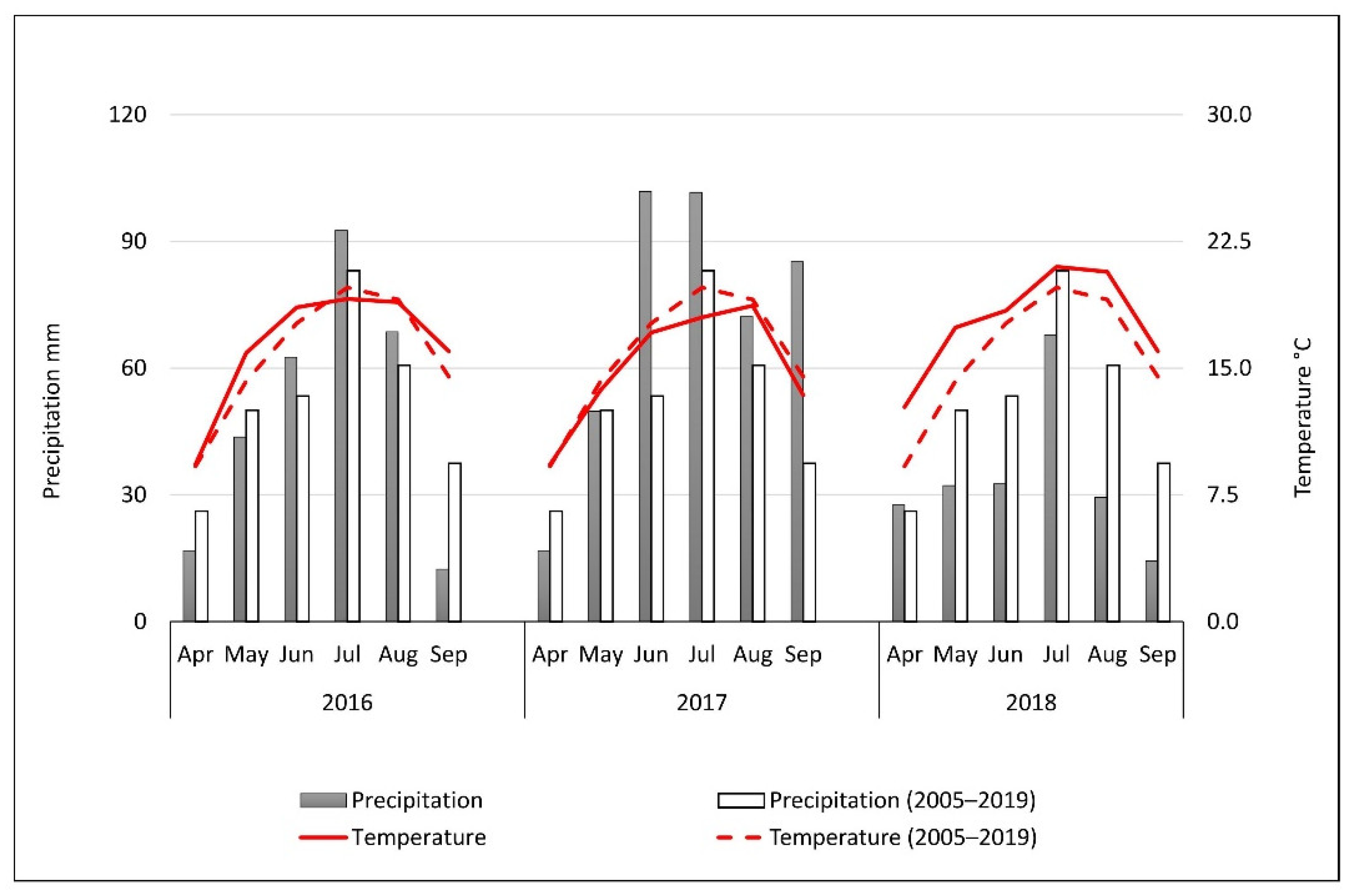
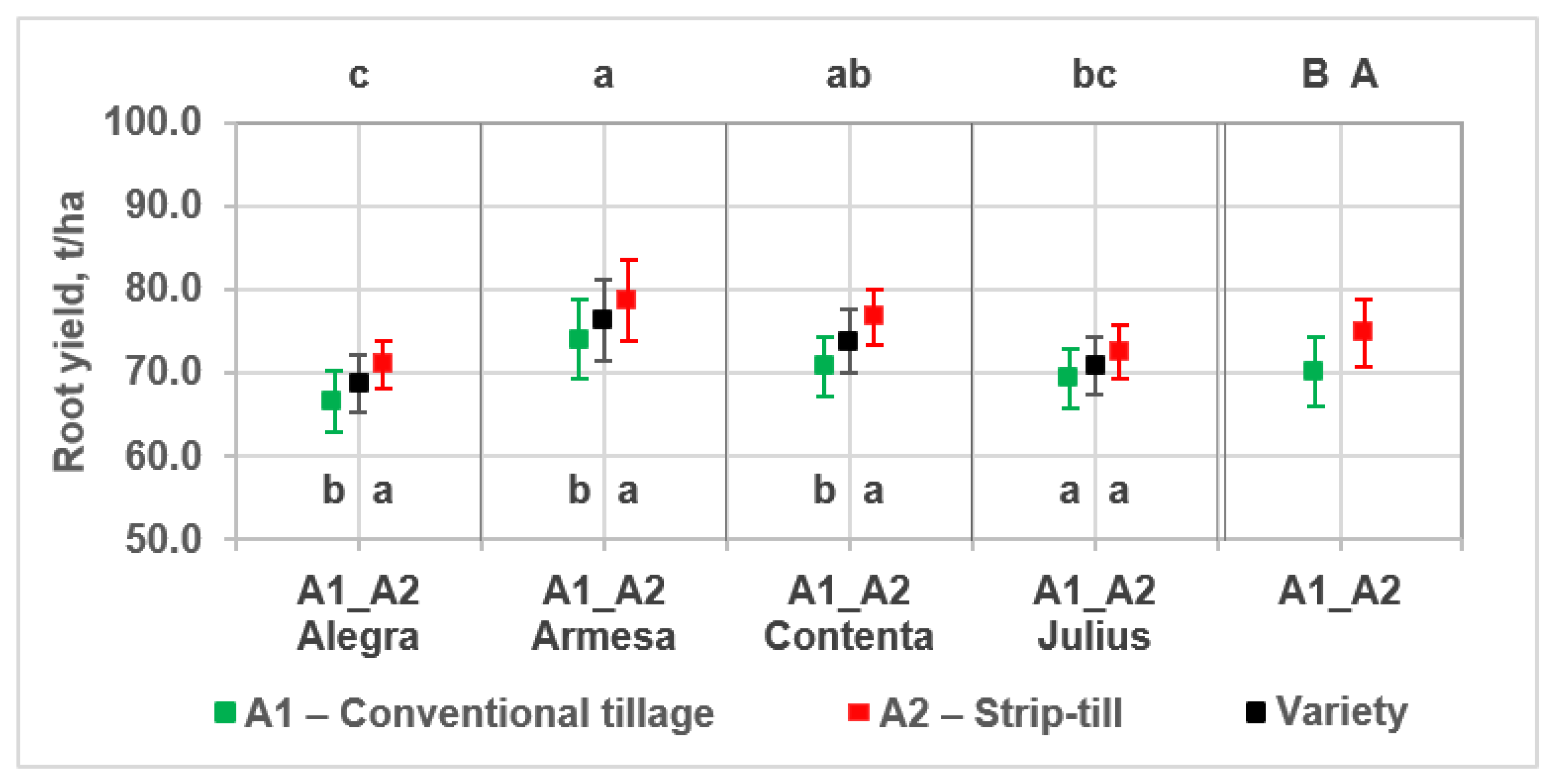
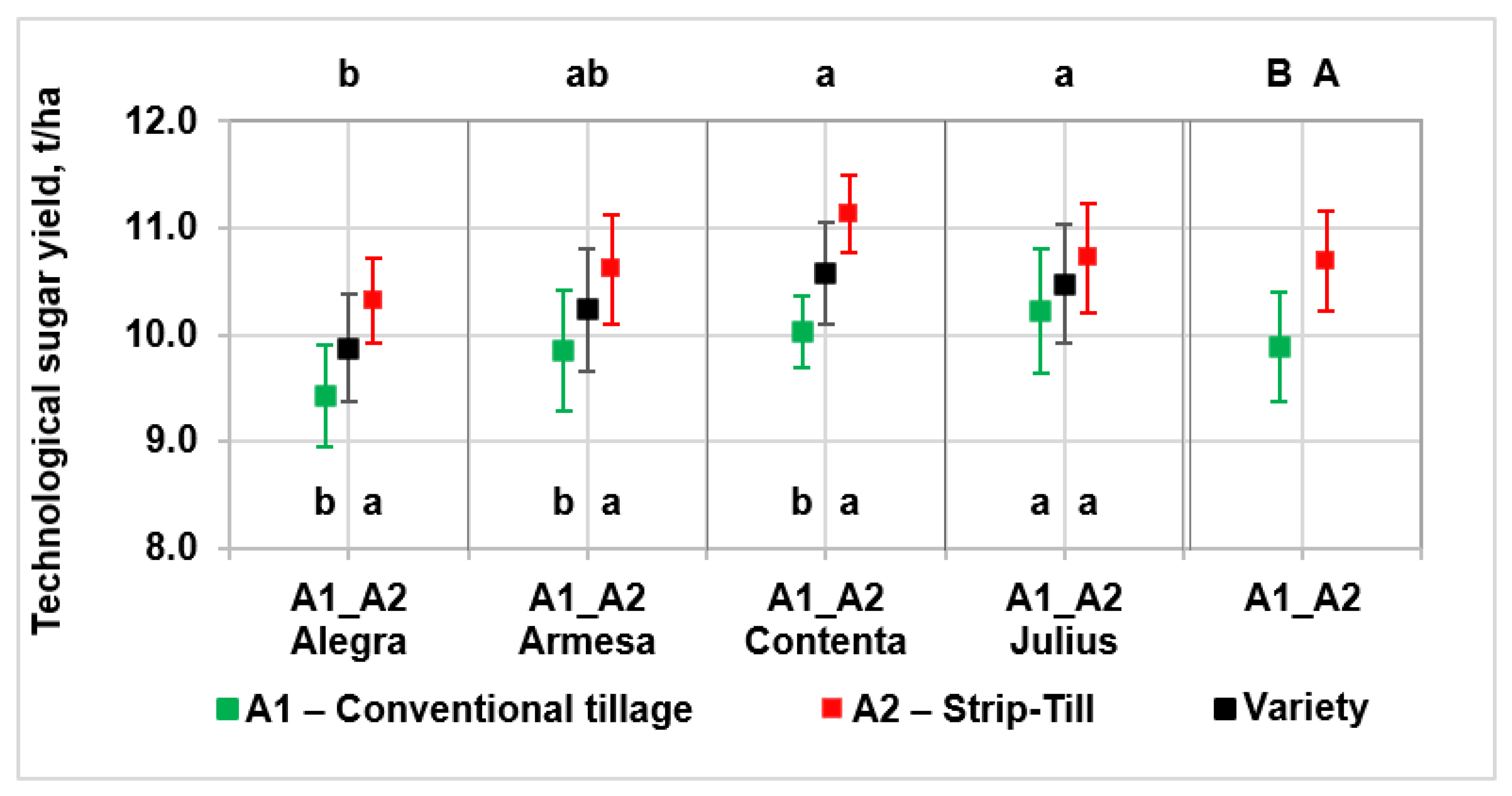
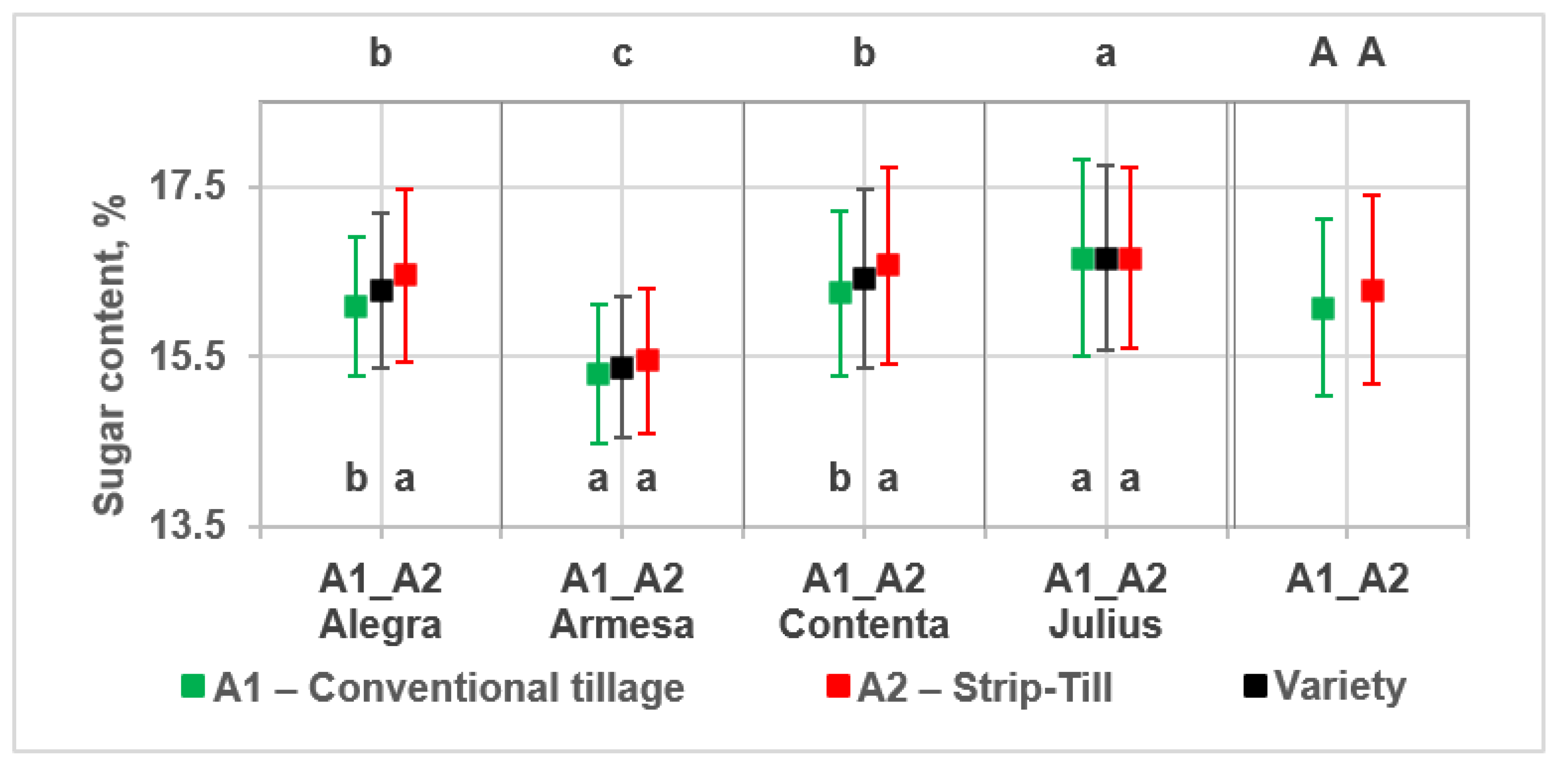
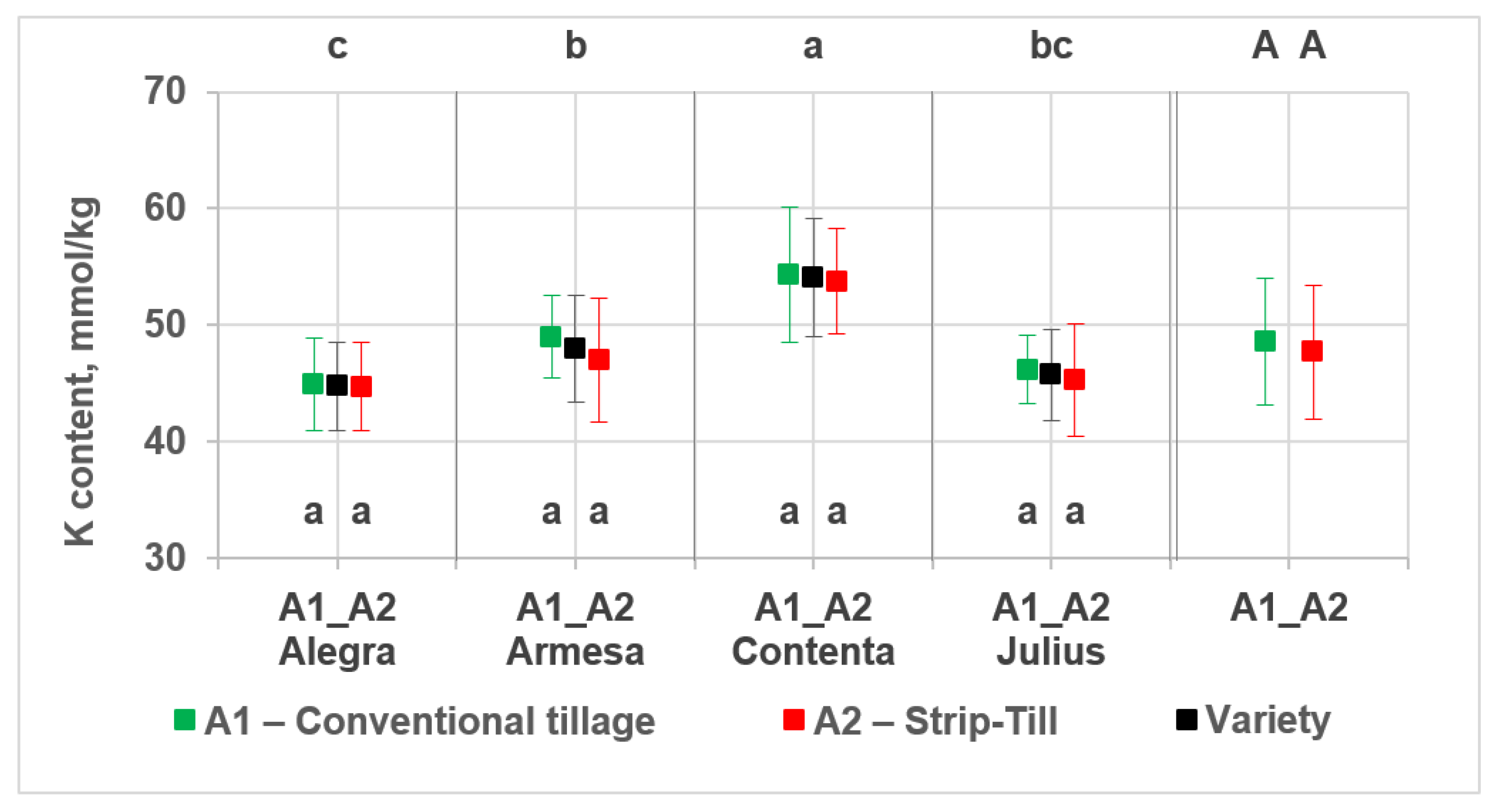


| Variety | Breeder | Representative | Type | Year of Registration |
|---|---|---|---|---|
| Alegra | DLF Seeds A/S Roskilde, Denmark | Hilleshög sp. z o.o. Iława, Poland | N | 2012 |
| Armesa | DLF Beet Seed ApS Holeby, Denmark | Hilleshög sp. z o.o. Iława, Poland | N | 2014 |
| Contenta | DLF Seeds A/S Roskilde, Denmark | Hilleshög sp. z o.o. Iława, Poland | N | 2015 |
| Julius | Strube D&S GmbH Söllingen, Germany | Hilleshög sp. z o.o. Iława, Poland | NZ | 2011 |
| Factor | Plant Growth Stage | |
|---|---|---|
| BBCH 12 | BBCH 49 | |
| Tillage system (A) | ||
| Conventional tillage | 99.79 ± 12.22 | 94.43 ± 13.01 |
| Strip-Till | 98.90 ± 10.09 | 94.88 ± 12.37 |
| ns | ns | |
| Variety (B) | ||
| Alegra | 98.71 ± 10.12 | 93.08 ± 10.60 |
| Armesa | 98.29 ± 11.23 | 95.59 ± 14.28 |
| Contenta | 100.42 ± 11.86 | 96.65 ± 14.57 |
| Julius | 99.96 ± 11.88 | 93.30 ± 10.98 |
| ns | ns | |
Publisher’s Note: MDPI stays neutral with regard to jurisdictional claims in published maps and institutional affiliations. |
© 2022 by the authors. Licensee MDPI, Basel, Switzerland. This article is an open access article distributed under the terms and conditions of the Creative Commons Attribution (CC BY) license (https://creativecommons.org/licenses/by/4.0/).
Share and Cite
Górski, D.; Gaj, R.; Ulatowska, A.; Miziniak, W. Effect of Strip-Till and Variety on Yield and Quality of Sugar Beet against Conventional Tillage. Agriculture 2022, 12, 166. https://doi.org/10.3390/agriculture12020166
Górski D, Gaj R, Ulatowska A, Miziniak W. Effect of Strip-Till and Variety on Yield and Quality of Sugar Beet against Conventional Tillage. Agriculture. 2022; 12(2):166. https://doi.org/10.3390/agriculture12020166
Chicago/Turabian StyleGórski, Dariusz, Renata Gaj, Agnieszka Ulatowska, and Wojciech Miziniak. 2022. "Effect of Strip-Till and Variety on Yield and Quality of Sugar Beet against Conventional Tillage" Agriculture 12, no. 2: 166. https://doi.org/10.3390/agriculture12020166
APA StyleGórski, D., Gaj, R., Ulatowska, A., & Miziniak, W. (2022). Effect of Strip-Till and Variety on Yield and Quality of Sugar Beet against Conventional Tillage. Agriculture, 12(2), 166. https://doi.org/10.3390/agriculture12020166








